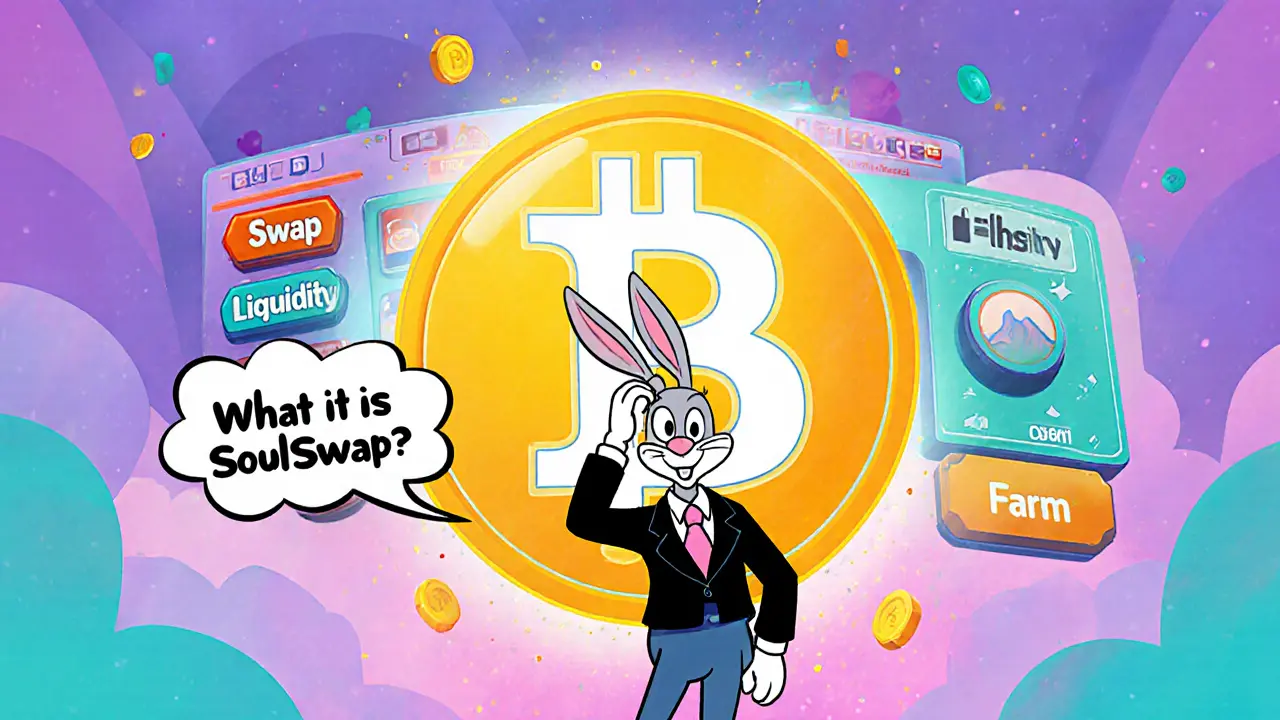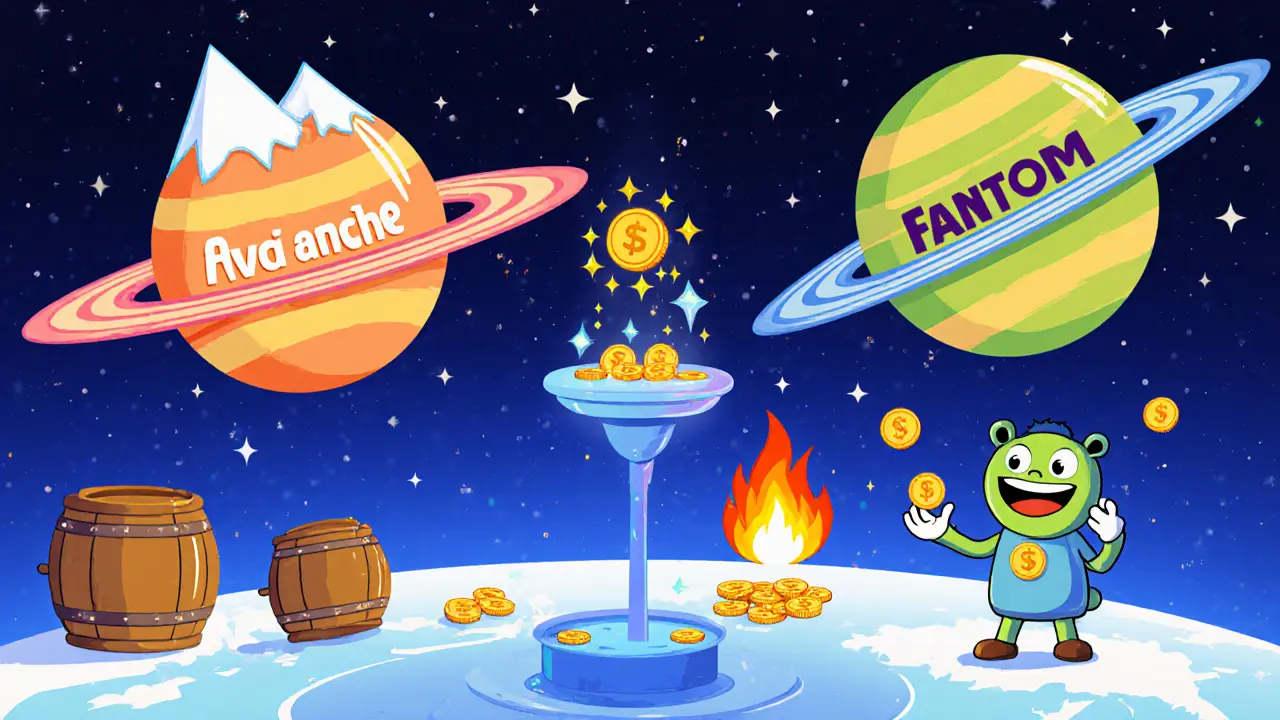SoulSwap Finance (SOUL) Crypto Coin Explained
 Jan, 24 2025
Jan, 24 2025
SoulSwap (SOUL) Token Valuation Calculator
Ever stumbled across a tiny token called SoulSwap Finance and wondered if it’s the next big DeFi play? You’re not alone. The crypto world is flooded with projects promising revolutionary swaps, yield farms, and multi‑chain magic, but most never move beyond a few lines of code. This guide breaks down exactly what SoulSwap Finance (SOUL) is, how its tech works, why its market numbers look so strange, and what you should consider before even thinking about a trade.
What is SoulSwap Finance (SOUL)?
SoulSwap Finance is a decentralized finance (DeFi) platform that operates as an automated market maker (AMM) exchange. It lets users swap assets across Avalanche and Fantom, provide liquidity for yield farming, borrow and lend, trade with leverage, and even launch new tokens-all within a single ecosystem. The native utility token that fuels the protocol is called SOUL.
Core Features at a Glance
- Cross‑chain token swaps between Avalanche (AVAX) and Fantom (FTM) networks.
- Liquidity pools that reward providers with a share of transaction fees and a portion of newly minted SOUL.
- Yield farming strategies that auto‑compound rewards across supported chains.
- Lending & borrowing markets where you can earn interest on deposited assets or take out short‑term loans.
- Leveraged trading desks for higher‑risk, higher‑reward positions.
- Token launchpad for bootstrapping new projects on the Soul Protocol suite.
Tokenomics: Supply, Fees, and Deflation
Understanding a token’s economics is key before you lock any capital. As of October2023, SOUL has a circulating supply of 191,177,735 tokens out of a hard cap of 250,000,000. That means roughly 76.5% of the total supply is already in the wild.
Every swap or liquidity action incurs a small fee. Part of the fee is burned-removing tokens forever-while the rest is redistributed to liquidity providers. The exact burn rate isn’t publicly broken down, but the design aims to keep inflation low compared to platforms like PancakeSwap, which have faced criticism for excessive token minting.
Because the token is used for governance, staking, and fee distribution, holders can earn a modest return simply by locking SOUL in the protocol’s staking contracts.

Technical Architecture: How SoulSwap Differs
Automated Market Maker (AMM) models are the backbone of modern DEXs. SoulSwap builds on Uniswap’s classic constant product formula (x*y=k) but adds a few twists:
- Multi‑chain deployment: Smart contracts live on both Avalanche and Fantom, with a bridge that moves liquidity and rewards without spawning extra inflation.
- Governance upgrades: The protocol claims to remove the “oligarchy” seen in Uniswap’s voting system, though exact voting thresholds aren’t disclosed.
- Dynamic rewards: Rewards are calculated separately on each chain, allowing the protocol to keep incentives balanced without over‑minting.
The platform’s front‑end resembles other AMM interfaces: you pick a pair, input an amount, and hit “Swap”. Under the hood, the router routes the transaction to the appropriate chain’s pool, settles fees, and updates the reward ledger.
Market Snapshot (Oct2025)
Despite the tech hype, SOUL’s market data tells a stark story:
- Current price: roughly $0.000038USD (varies slightly across trackers).
- Market cap: about $30,800.
- 24‑hour trading volume: less than $1 (some sources report $0.00).
- CoinMarketCap rank: #6,474; Bitget rank: #6,813.
Low volume means there’s barely any liquidity to execute even modest trades without massive slippage. In practice, the DEX is almost non‑functional for real users.
How Does SoulSwap Stack Up? (Comparison Table)
| Metric | SoulSwap (SOUL) | Uniswap | PancakeSwap | SushiSwap |
|---|---|---|---|---|
| Chains Supported | Avalanche, Fantom | Ethereum, Polygon, Arbitrum, Optimism, … | Binance Smart Chain, Ethereum, … | Ethereum, BSC, Polygon, … |
| 24h Volume | $0‑$1 | ~$1.2B | ~$350M | ~$120M |
| Market Cap | $30.8K | $3.9B | $528M | $112M |
| Token Supply (max) | 250M SOUL | Unlimited (UNI) | 600M CAKE | 250M SUSHI |
| Governance Model | Proposed multi‑chain voting (details opaque) | UNI token voting | CAKE staking & voting | SUSHI token voting |
The numbers make it clear: SoulSwap is a micro‑player with virtually no liquidity, whereas the others dominate billions in daily trades.

Risks and Red Flags
Before you even think about buying SOUL, consider these warning signs:
- Liquidity vacuum: With less than a dollar of daily volume, any trade will suffer extreme price impact.
- Anonymous team: No known developers, no audited code publicly linked, and no clear roadmap beyond the 2021 launch.
- Sparse community: Zero followers on CoinMarketCap, no active Discord or Telegram, and barely any Reddit chatter.
- Exchange listings: The token is absent from major centralized exchanges, limiting exposure.
- Potential rug‑pull: Low market cap & low holder count make it easy for a single actor to dump large amounts.
All these factors push SoulSwap into the “high risk / speculative” bucket.
How to Interact with SoulSwap (If You Still Want To)
- Set up a Web3 wallet: Install MetaMask (or any EVM‑compatible wallet) and add the Avalanche and Fantom networks using the RPC URLs from the official docs.
- Acquire AVAX or FTM: You’ll need the native chain token to pay gas fees. Purchase on a major exchange, then bridge to the appropriate network.
- Visit the DEX: Go to soulswap.finance (ensure the URL matches the official site).
- Connect your wallet: Click “Connect Wallet” and approve the connection in MetaMask.
- Check available pools: The UI lists a handful of pairs-most of them have near‑zero liquidity.
- Swap or add liquidity: If you find a pool with at least a few thousand dollars of liquidity, you can try a tiny swap (e.g., $1) to test slippage.
- Beware: even a $1 swap could move the price by tens of percent if the pool is tiny.
Given the current state, most users will hit a dead end at step5 because there simply aren’t any meaningful pools to interact with.
Future Outlook - Is There Hope?
From a technical standpoint, the idea of a multi‑chain AMM with dynamic rewards is sound. In practice, however, a DEX lives or dies by the liquidity it can attract. Without a strong community, strategic partnerships, or a clear incentive program, SoulSwap’s token is unlikely to see price appreciation.
Some analysts argue that a “pump‑and‑dump” scenario could briefly lift SOUL’s price if a whale decides to market it aggressively. That would be a short‑term spike, not sustainable growth. For long‑term investors, the odds favor established platforms that already process billions in volume.
If you’re curious about the technology, you can study the smart‑contract code on the Avalanche explorer. But for actual financial exposure, keep the risks on your radar and consider allocating capital to higher‑liquidity, audited DeFi projects instead.
Frequently Asked Questions
What blockchain does SoulSwap operate on?
SoulSwap is deployed on Avalanche (AVAX) and Fantom (FTM) networks, both of which are EVM‑compatible blockchains.
How many SOUL tokens exist?
The maximum supply is 250million SOUL, with about 191million already circulating.
Is SoulSwap safe to use?
Safety is uncertain. The code hasn’t undergone a widely‑recognized third‑party audit, and the platform lacks an active community to flag issues.
Can I earn yield on SOUL?
Yes, by providing liquidity to the few existing pools or staking SOUL in the protocol’s farming contracts, but rewards are tiny due to low volume.
Why is the trading volume so low?
Liquidity is a chicken‑and‑egg problem: without users, there’s no volume; without volume, users stay away. SoulSwap hasn’t attracted enough traders or partnerships to break this cycle.
ചഞ്ചൽ അനസൂയ
January 24, 2025 AT 03:30Seeing the liquidity vacuum on SoulSwap really makes you think about the fundamentals of any DeFi project. If there’s no depth in the order books, even a tiny trade can swing the price wildly. It’s a good reminder to always test with the smallest amount possible before committing larger capital. Keep your risk management tight and stay curious about where the community might grow next.
Orlando Lucas
January 24, 2025 AT 06:40When you look at the numbers, the picture becomes clearer than any marketing hype can convey. The market cap sits under forty thousand dollars, which is minuscule in the crypto arena. Volume hovering around a single dollar means price discovery is practically non‑existent. Liquidity pools that exist are so shallow they’d drown under a modest trade. This creates a feedback loop where traders stay away, keeping the volume low, which in turn scares away new liquidity providers. From a philosophical standpoint, it’s a demonstration of how value is a collective belief that needs participants to sustain itself. Without a vibrant user base, the token’s utility remains theoretical. The cross‑chain ambition is interesting, but ambition without execution is just a blueprint. You could argue the token’s design tries to solve real problems, yet the practical adoption metrics tell a different story. The burn mechanism sounds appealing, but if there’s no demand, burning tokens does little to create scarcity. The governance model is opaque, leaving potential delegates guessing about influence. In short, the token feels like a prototype awaiting real users. If the team can attract partnerships, perhaps the dynamics will shift. Otherwise, it risks staying in the niche corner of DeFi. The takeaway, then, is to treat this as a high‑risk experiment rather than a solid investment. Keep an eye on any community initiatives that could break the liquidity deadlock.
Philip Smart
January 24, 2025 AT 10:50Honestly, the whole thing looks like a textbook case of hype without substance. The code hasn’t even been audited publicly, which is a red flag for any smart‑contract platform. You’d be better off allocating that capital to a DEX with proven volume.
Jacob Moore
January 24, 2025 AT 14:26If you do decide to dip a toe in, start with a $1 swap just to see the slippage. Most pools will slam the price up by double digits, so keep expectations realistic. Also, make sure your wallet is set up on both Avalanche and Fantom before you start moving tokens.
Manas Patil
January 24, 2025 AT 18:20The multi‑chain approach is technically sound, especially for users who bounce between AVAX and FTM. However, without a strong incentive layer, liquidity providers have little reason to bridge assets. It’s a classic case of good architecture needing a solid economic model to thrive.
Annie McCullough
January 24, 2025 AT 22:13Sounds like a hype train 🚂
Lady Celeste
January 25, 2025 AT 02:06Low volume, anonymous team, and no community – the risk factor is off the charts. It’s a textbook rug‑pull scenario.
Ethan Chambers
January 25, 2025 AT 06:00If you’re looking for sophisticated DeFi engineering, SoulSwap barely scratches the surface. The tokenomics lack transparency, and the liquidity pools are practically nonexistent. It feels like a placeholder project rather than a serious contender.
gayle Smith
January 25, 2025 AT 09:53Community vibes are dead silent, which tells you a lot about the long‑term prospects. No Discord, no active forum, just an empty shell.
mark noopa
January 25, 2025 AT 13:46From a pseudo‑philosophical angle, the idea of a decentralized exchange that spans two EVM‑compatible chains is alluring, yet the execution feels half‑baked. The token’s supply is capped at 250 million, but 191 million already circulate, leaving little room for future growth without inflation. The burn‑and‑redistribute mechanism is a neat concept but loses its sparkle when there’s virtually no trading activity to fuel it. In practical terms, the platform’s UI is reminiscent of mainstream DEXes, but you’ll hit a wall at step five due to the near‑zero liquidity. The risk of a single whale dumping their stash is real, considering the market cap hovers around $30 k. That little cap makes price manipulation trivially easy. The lack of an audited codebase adds another layer of insecurity, especially for newcomers. If you’re chasing high‑risk, high‑reward scenarios, this could be a candidate, but it’s more likely to implode than soar. Bottom line: treat SoulSwap as an experimental sandbox rather than a portfolio anchor.
Rama Julianto
January 25, 2025 AT 17:40Stop wasting time on a platform that can’t even attract a single active trader. The numbers scream “do not invest”, and the code has zero public audits. Pull back now before you get burned.
Helen Fitzgerald
January 25, 2025 AT 21:33For anyone curious, you can still explore the smart‑contract code on the Avalanche explorer to satisfy that tech itch. Just remember, curiosity doesn’t replace due diligence.
Jon Asher
January 26, 2025 AT 01:26Keep things simple: if the pool you want has less than a few thousand dollars, walk away. No need to gamble on thin order books.
Anjali Govind
January 26, 2025 AT 05:20The cross‑chain bridge idea is neat, but without user incentives, it stays just a concept.
Sanjay Lago
January 26, 2025 AT 09:13Optimism is great, yet it needs backing from real liquidity. If the team can spark a few big farms, the token might see a tiny uptick.
arnab nath
January 26, 2025 AT 13:06It’s almost as if the developers are hiding behind the code, waiting for a perfect moment to disappear with whatever they’ve minted.
Nathan Van Myall
January 26, 2025 AT 17:00The current data shows less than one dollar of daily volume, which makes any price impact extreme.
debby martha
January 26, 2025 AT 20:53Not impressed, seems like a flash in the pan.
Ted Lucas
January 27, 2025 AT 00:46Zooming in on the tokenomics, you’ll notice the inflation rate is already high, and with barely any users, the future looks shaky 😬.